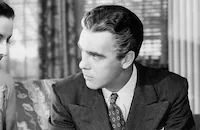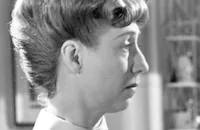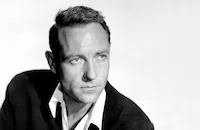Bud Abbott and Lou Costello in Hollywood

Brief Synopsis
Cast & Crew
S. Sylvan Simon
Bud Abbott
Lou Costello
Frances Rafferty
Robert Stanton
Jean Porter
Film Details
Technical Specs

Synopsis
At the busy Hollywood Shop, the "barber shop to the stars," seasoned barber Buzz Kurtis tries to teach his clumsy pal Abercrombie how to shave customers. Abercrombie practices on an air-filled balloon covered with shaving cream, which explodes in his face when he loses control of the razor. Later, at the office of motion picture agent Norman Royce, Buzz and Abercrombie are in the middle of giving the agent a shave and a shoeshine when Jeff Parker, a singer from Des Moines, arrives looking for an agent to represent him. Impressed by Jeff's singing, Norman decides to recommend him for the romantic lead opposite Claire Warren in director Dennis Kavanaugh's next picture. Leading man Gregory LeMaise was to star in the film, but gave up the part and canceled his contract with Norman. The seeming ease with which Norman makes lucrative movie deals persuades Buzz and Abercrombie to become agents themselves, and they begin by convincing Jeff that he should be their first client. A short time later, at the main entrance to Mammoth Studios, Buzz and Abercrombie accidentally crash their car into Kavanaugh's car and are ordered off the lot. While Kavanaugh signs Jeff to star in his new film, Buzz and Abercrombie try to elude the studio police long enough to find Kavanaugh. Later, to celebrate Jeff's new contract, Kavanaugh, Buzz and Abercrombie take the new star to Ciro's nightclub. There Gregory tells Kavanaugh that he has changed his mind and has decided to resume his role in the film. Kavanaugh, not wanting to take a risk on Jeff, takes Gregory back and cancels his contract with Jeff. Claire, who has fallen in love with Jeff, vows to fight Kavanaugh's decision, but Jeff tells her that he has decided to give up his attempt to break into show business and that he will be returning to Des Moines. Desperate to keep their client from leaving Hollywood, Buzz and Abercrombie decide to prevent Gregory from appearing in the film by devising a plan to get the actor arrested. As part of their plan, Buzz and Abercrombie board the actor's boat and provoke him into committing an assault against Abercrombie. Gregory punches Abercrombie so hard, though, that he is propelled into the water. Although Abercrombie swims back to shore, Buzz tells him to hide so that he can accuse Gregory of murder. When Buzz threatens to go to the police, Gregory drops out of sight and is labeled a fugitive by the press. Later, at a bar, Gregory discovers that Abercrombie is alive and chases after him. The chase continues through the amusement park set of Kavanaugh's film, and their ensuing wild roller coaster ride is captured on film. Although the chase adds just the right amount of excitement to the film to make it a hit, Abercrombie and Buzz soon find themselves back at their old jobs at the barber shop.

Director

S. Sylvan Simon
Cast

Bud Abbott

Lou Costello

Frances Rafferty
Robert Stanton

Jean Porter

Warner Anderson

"rags" Ragland

Mike Mazurki
Carleton G. Young

Donald Macbride
Edgar Dearing

Marion Martin
Arthur Space
Wm. "bill" Phillips
Robert E. O'connor
Katharine Booth
The Lyttle Sisters

Dean Stockwell
Sharon Mcmanus

Lucille Ball

Jackie "butch" Jenkins

Preston Foster

Robert Z. Leonard
Chester Clute

Marie Blake
Wheaton Chambers
Harry Tyler
William Tannen
Skeets Noyes
Nolan Leary
Garry Owen
Forbes Murray
Ed O'neill
Joe Bacon
Dick Alexander
Hank Worden
Dick Winslow

Jane Hale
Mitzie Uehlein
Nita Matthews
Frank Scannell
William Hawley
Arno Frey
Helen Boice

King Baggott
William Frambes
Betty Blythe
Broderick O'farrell
George Calliga

Lee Phelps
Walter Soderling
Frank Penny
Frank Darien
Henry Hall
Bert Roach
Frank Hagney
Clancy Cooper
Nick "nicodemus" Stewart
Milton Kibbee
Joe Devlin
Del Henderson
Harold Degarro

Chester Conklin

Charles Walters
Art Miles
Beverly Haney
Barbara Combs
Zaz Vorka
Mary Donovan
Charles Mcnally
Gerald Perreau
Bunny Waters
Sarah Edwards
Anne O'neal
Crew
Mano Artzt
George Bassman
Ralph Blane
Lou Breslow
Bobbie Canvin
Kay Carter
Earl Cates
Jack Dawn
Peter P. Decker
Dale Deverman
Hans Dreier
Ted Duncan
Howard Fellows
James Z. Flaster
Cedric Gibbons
A. Arnold Gillespie
Martin A. Gosch
Martin A. Gosch
Irene
Joe Karnes
Standish J. Lambert
Ben Lewis
M. J. Maclaughlin
Hugh Martin
Earl Mcevoy
Nat Perrin
Nat Perrin
Wade B. Rubottom
Charles Schoenbaum
Douglas Shearer
Robert W. Shirley
Art Smith
Newell Sparks
William Steinkamp
Michael Steinore
Valles
Charles Walters
John A. Williams
Edwin B. Willis

Photo Collections
Videos
Movie Clip



Trailer
Film Details
Technical Specs

Articles
Classic Comedy Teams Collection - Abbott & Costello, Laurel and Hardy and The Three Stooges Are Featured in CLASSIC COMEDY TEAMS COLLECTION
The Abbott and Costello disc is easily the strongest. The duo was allowed to make one film a year away from their home studio of Universal so during the peak of their popularity they went three times to MGM. Two of those films are in this set and can't be found in the otherwise comprehensive four volume Best of Abbott & Costello (the third film, 1941's Rio Rita, has yet to appear on DVD). Lost in a Harem (1944) shows more of the MGM gloss than Abbott & Costello's usual films even if the story about the two rescuing a blonde singer (B-movie perennial Marilyn Maxwell) and overthrowing an evil ruler is a bit thin. The film makes good use of sets left over from Kismet and there's a song and a half from the Jimmy Dorsey band. Abbott and Costello are generally quite lively with a mix of slapstick and verbal routines, even at one point recreating the classic vaudeville bit "Slowly I Turned." Slightly more predictable is Abbott and Costello in Hollywood (1945), the first film to feature their name in the title. This time the two are show biz barbers who decide that being a talent agent is the ticket to easy money so they promote an Iowa-fresh singer over an established star. The film tends more towards a string of routines though there are some good ones including the two trying to cure Costello's insomnia, him pretending to be a stunt dummy and even a frantic chase at the end. The big missed opportunity was to exploit the Hollywood setting more; there are cameos from Lucille Ball, Rags Ragland and Preston Foster but that's about it.
Like Abbott and Costello, the Laurel and Hardy disc collects two MGM wartime films but in this case that's a bit past their prime period. Still, Laurel and Hardy bring unflappable good cheer and years of experience that give these films a charm that would certainly have been lacking if anybody else had starred. Air Raid Wardens (1943) opens with a voice-over straight out of Our Town, describing the small community that's about to participate in the war. Laurel and Hardy ran a string of failed businesses and now have been rejected by the military as well they end up as, you guessed it, air raid wardens. Not much to the warden angle so we also get Nazi spies, a stuffy bank president, a short-tempered teamster and even a rambunctious stray dog. There's a nice bit with the two trying to enter a town meeting quietly and an inventive gag with a carrier pigeon. Nothing But Trouble (1944) stretches everything a bit more thin. Seems that there's an exiled teenage king from some operetta country who just want to be a regular boy and play football. Laurel and Hardy befriend him, thinking he's just a wayward kid but not much happens. The film had been pitched a couple of years earlier and at one point involved helicopters and gags by Buster Keaton. None of that is in the final film; the studio must have decided that "Imagine Laurel and Hardy as a chef and a butler" was good enough and less expensive. Though the king's story is mostly padding, you're not likely to forget Stan trying to serve at a high-class dinner party and may even have fond memories of the two trying to grab a steak (actually horsemeat) from the lion's cage at the zoo.
The Three Stooges disc is something of an oddity since the team plays only supporting roles in both films. Meet the Baron (1933) is the more interesting since it's an example of the goofy, anything-goes comedies of the early 30s though admittedly not one of the better ones. The film was designed to put onto screen Jack Pearl, whose recreation of eternal tall tale teller Baron Munchausen had been a radio and stage smash in preceeding years (and would quickly vanish: he appeared in only one other film while his radio career trickled out). With Jimmy Durante as his buddy, the Baron crashes an all-girls college where the janitors are Ted Healey and His Stooges (that's right, not yet the Three Stooges). So you get a lot of running around, recreations of Pearl's radio skits, the Stooges pummelling each other and for good measure about thirty co-eds bathing and singing in an enormous Art Deco shower. Completing the disc is 1951's Gold Raiders, a creaky B-Western that looks like it should have appeared 15 years earlier. It's also an independent production and the only non-MGM film in this set. Gold Raiders shows that with merely a few days on the back lot and minimal editing you can keep an entire film under an hour. An aging, paunchy George O'Brien is the hero (an insurance agent!) trying to keep the local mine from being taken over by an evil landowner. The Stooges are travelling salesmen who help O'Brien but since they're incidental to the story any comedy is fleeting.
Overall the transfers in the Classic Comedy Teams Collection are sharp but the sources aren't always the best quality. Gold Raiders has some abrupt splices, including one that clips off a bit of dialogue. Lost in a Harem has a lot of speckling and in one part noticable print damage (which fortunately lasts barely a second or so). The only extras are a few trailers and subtitle options (English, French and Spanish). Still, the set is inexpensively priced and anybody interested in the films will be glad to have them.
For more information about Classic Comedy Teams Collection, visit Warner Video. To order Classic Comedy Teams Collection, go to TCM Shopping.
by Lang Thompson

Classic Comedy Teams Collection - Abbott & Costello, Laurel and Hardy and The Three Stooges Are Featured in CLASSIC COMEDY TEAMS COLLECTION
Abbott and Costello in Hollywood
As with most A & C vehicles, the plot is typically incidental: Buzz (Bud) and Abercrombie (Lou) have dead-end careers as a barber and porter for a swanky Hollywood salon. While making an office call on high-powered agent Horman Royce (Warner Anderson), they marvel at the percentages he takes in and decide that this is the racket for them. To that end, they appoint themselves as representation for Jeff Parker (Robert Stanton), a kid from the sticks with obvious singing talent and the recipient of a recent brush-off from Royce. Jeff finds another champion in Claire Warren (Frances Rafferty), an ex-colleague of Buzz and Abercrombie's who's now a rising starlet.
Wearing the black hat in this scenario is Royce's client, the smug screen crooner Gregory Lemaise (Carleton Young), who sees the gifted Jeff as a threat to his designs on Claire as well as his plans for her upcoming musical, currently in production. While his hapless handlers are dodging the grasp of studio security, Jeff wins the part that Lemaise had walked out on; Lemaise spitefully responds by leaning on the producers and wresting the role back from the unknown. The wanna-be agents cook up a convoluted scheme to prevent Lemaise's further participation in the film, with the upshot being the furious heavy's pursuit of Abercrombie across a roller coaster (a fun sequence shot on the musical's elaborate midway set).
MGM had struck a once-a-year option for Bud and Lou's services, and while one would have thought that production values might have increased from what A&C were used to over at Universal, it seems that the opposite had been the case. MGM wrung substantial savings out of the convenient back lot settings, with the bulk of the budget being reflected in the production number finale. Further, while you'd think the MGM talent roster would provide a steady stream of walk-ons, the amount delivered--Lucille Ball, Preston Foster, Robert Z. Leonard, "Rags" Ragland, Jackie Jenkins--is surprisingly slight.
Like any other A&C film, though, Abbott and Costello in Hollywood is at its best when the decks are cleared and Bud and Lou are allowed to cut loose. Easily the best comic sequence finds Costello in the throes of insomnia. An unusually compassionate Abbott offers his buddy a sleep-aid phonograph record, which works fine to a point--when the skipping at the end of the record jars Lou awake. Bud's offer to stand vigil over the Victrola proves a bust, as the record makes him conk out immediately. The hilarious exchange where they try to rectify the situation with earplugs was excerpted for That's Entertainment, Part II (1976).
It's pretty much a given that Abbott and Costello primarily regarded the plots of their films as frameworks on which they could drape their vast repertoire of proven comic chestnuts. Abbott and Costello in Hollywood scenarist Nat Perrin confirmed as much to Bob Furmanek and Ron Palumbo in their exhaustive survey of the team entitled, aptly enough, Abbott and Costello in Hollywood (Perigee). "They would do the general idea of what was written, then throw in whatever came into their heads, just to get it done in one take," Perrin recalled. "I saw that as a terrible waste, because I thought that Costello was an extremely talented guy, as was Abbott in his way. But they weren't fussy about what they were going to do."
Jean Porter, the petite, pretty contract player cast as Costello's love interest, recalled for Furmanek and Palumbo the convivial atmosphere that earmarked a typical A&C shoot. "[T]he jokes were worth it. I think that comforted them," stated Porter. "I think when they could play around fool around and have other people join in--and they had a lot of their old buddies with them on- and off-camera--that made them comfortable." Soon after Abbott and Costello in Hollywood wrapped, MGM announced that the team's annual option would no longer be picked up, and the duo happily headed back to Universal's familiar confines, where they would primarily ply their comic craft for another decade.
Producer: Martin A. Gosch, S. Sylvan Simon
Director: S. Sylvan Simon
Screenplay: Nat Perrin, Lou Breslow (based on a story by Nat Perrin and Martin A. Gosch)
Cinematography: Charles Edgar Schoenbaum
Film Editing: Ben Lewis
Art Direction: Cedric Gibbons, Wade B. Rubottom
Music: George Bassman
Cast: Bud Abbott (Buzz Kurtis), Lou Costello (Abercrombie), Frances Rafferty (Claire Warren), Bob Haymes (Jeff Parker, as Robert Stanton), Jean Porter (Ruthie), Warner Anderson (Horman Royce), Mike Mazurki (Klondike Pete), Carleton G. Young (Gregory Lemaise).
BW-83m. Closed captioning.
by Jay S. Steinberg
Abbott and Costello in Hollywood
Quotes
Trivia
After the disappointing performance of this film at the box office, MGM dropped its option to produce more Abbott & Costello films.
Notes
Some contemporary sources list the title of this film as Abbott and Costello in Hollywood. The working title for the film was Close Shave. The picture marked Martin Gosch's initial effort as a producer for M-G-M, and was the first film for Bud Abbott and Lou Costello under their new contract with M-G-M. Dance director Charles Walters appeared onscreen in the minor role of "sailor." A July 1945 New York Times article notes that the film was to have been the first of many M-G-M films starring former Universal players Bud Abbott and Lou Costello, but that the contract between the studio and the comedy team, which called for one film per year for four years, was later abrogated. Mano Artzt, who was hired as a technical advisor on the film, was head of the M-G-M barber shop. M-G-M studio records indicate that the song "Put a Little Salt on the Bluebird's Tail" was recorded for the film but not used.

Miscellaneous Notes
Released in United States 1945
Released in United States 1945














